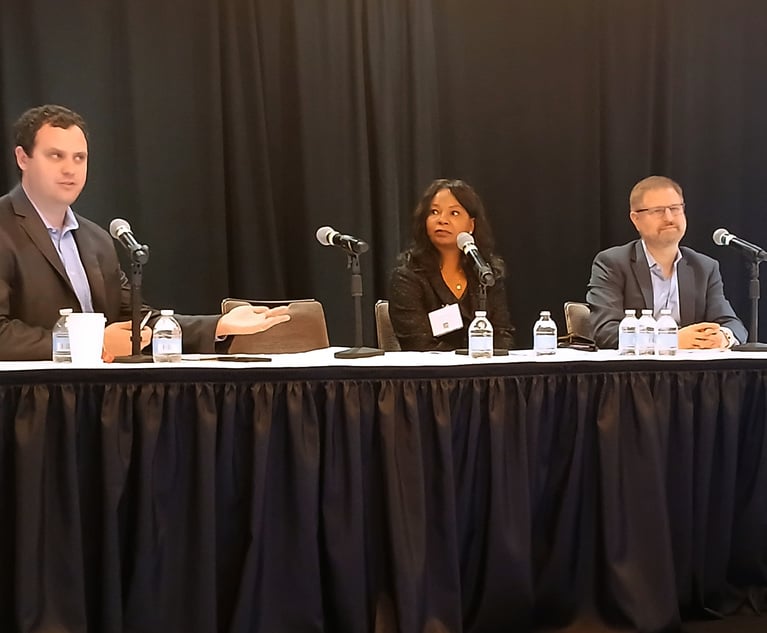Clock Work: Wage and Hour Cases Top Employment Class Actions
Wage and hour cases outpace all other types of employment class actions.
February 28, 2010 at 07:00 PM
23 minute read
In December 2009, a plaintiffs firm filed collective actions against AT&T subsidiaries in Atlanta and San Francisco federal courts, seeking $1 billion in damages and back pay for approximately 5,000 current and former workers. The lawsuit alleges that the company misclassified first-level managers as exempt from overtime pay.
Despite the huge potential liability, news of the case made barely a ripple in the employment law community, an indication that Fair Labor Standards Act (FLSA) claims seeking huge damages have become almost routine.
In 2009, wage and hour litigation continued to outpace all other types of workplace class actions, according to Seyfarth Shaw's Sixth Annual Workplace Class Action Litigation Report, released in January. Collective actions under the FLSA outnumbered all other types of private employment class actions for the fourth straight year, and claims under state laws increased as well. The report predicted more of the same in 2010.
“In dealing with workplace issues, wage and hour class actions are the No. 1 area of concern,” says Gerald Maatman, a partner at Seyfarth Shaw.
Many collective actions, like the AT&T litigation, allege that employers improperly classify workers as exempt from overtime pay. Some focus on time employees spend getting ready for work, including “donning and doffing” uniforms. And the 24/7 workplace is starting to generate claims for time spent on after-hours work related e-mails and text messages.
Virtually any company can find itself defending a wage and hour case. Targets span a wide range of industries–insurance, pharmaceutical, telecom and financial services companies have been among recent defendants, and health care is the newest focus. Employment lawyers warn that it's not just mega-companies that are in the plaintiffs bar's sights: Restaurants, car washes and dry cleaners are also under fire.
“You see a trend toward small and midsized employers having these actions filed against them–employers who can't afford to pay to defend the cases,” says Paul Siegel, a partner at Jackson Lewis. “It's the Wild West of claims.”
Quick Return
There are several theories on why wage and hour class actions have proliferated faster than other employment cases. Maatman says the plaintiffs bar found it could realize a quick return on FLSA cases because the requirements for certifying a class are lower than for ERISA or Title VII claims. Section 216(b) of the FLSA basically just requires the plaintiffs lawyer to show that people in the proposed class are “similarly situated,” according to Maatman, while other class actions must meet the stricter tests of Rule 23 of the Federal Rules of Civil Procedure.
“Certification is so much easier, so the amount of time needed by the plaintiffs bar to create a certified case and gain settlement leverage and secure a return on their time is much, much less in a wage and hour case,” he says.
Another factor provoking the onslaught of wage and hour cases is the FLSA itself–a complicated statute enacted in 1938 for a very different workforce. The complications raised by BlackBerrys and laptops that tether people to their jobs, for example, have given a totally new meaning to “off the clock” work.
“It's an old law that employers are trying to adapt to 21st Century issues,” says Jackson Lewis partner Wendy Mellk.
For example, a whole genre of cases has developed over “computer boot-up time” in call centers that require employees to have their computer programs opened and headsets on so they are ready to take calls when their shift begins.
“If the employees have to report to their workstation before the shift begins, it converts that time into compensable time,” says James Coleman, a partner at Constangy, Brooks & Smith. “It's not a question of whether there is liability, but how much liability.”
Exemption Questions
A particular stumbling block in the federal law is the so-called administrative exemption, under which many white- and pink-collar workers are classified as exempt from overtime. To qualify under the administrative exemption, a job must include a role in “advising the business,” but the specifics are undefined.
“The administrative area is where the workforce has grown,” Siegel says. “There are uncertainties where people manage projects but not other workers, and the DOL has not clarified this.” The uncertainties have resulted in a rash of lawsuits by claims adjusters, loan originators, stockbrokers and others.
“People in these jobs make increasing amounts of money,” Siegel adds, making a back overtime pay award very expensive. “You may have overtime being due to people making $60,000 to $80,000 a year, which was not anyone's intention when the law was passed.”
For the plaintiffs bar, those cases often lead to quick, big paydays once they certify a class. “When employers look at these cases and calculate the potential damages, they resolve the claims because it's expensive to litigate the question of whether the employees are exempt,” Mellk says. “We are seeing plaintiffs lawyers climbing out of the woodwork because these cases tend to settle and the attorneys fee component [of the settlement] is significant.”
Siegel says the FLSA's lack of clarity on who qualifies for an administrative exemption puts employers in a bind.
“Someone needs to tell employers what the exemption means,” he says. “Until you know what the exemption means, how do you manage your business?”
State of Confusion
State wage and hour laws that differ from the federal statute are another source of confusion. Some states put a cap on the number of hours an employee can work per day, while the federal law caps the hours per week. Meal and rest breaks are not required under federal law, but they are in some states, including California, where they have spurred many class actions.
Some liabilities can be avoided through policies and training that encompass both state and federal rules, according to Shanti Atkins, president and CEO of ELT, an ethics and compliance training provider. “There are huge knowledge gaps among employees and managers in this area of law,” she says. “Having up-to-date policies and training that account for state law issues is a huge component in creating a litigation shield.”
For example, she says most employees would think it is OK for them to volunteer their time after their shift ends. “That's an example of a myth that is simple to dispel with some basic training,” she says.
Developing a complaint reporting process similar to those for discrimination and harassment complaints, and then assuring that someone follows up and takes remedial action if warranted also goes a long way toward creating an affirmative defense, Atkins adds.
“If you have all the pieces in place, you can have a substantial reduction in damages,” she says.
In December 2009, a plaintiffs firm filed collective actions against
Despite the huge potential liability, news of the case made barely a ripple in the employment law community, an indication that Fair Labor Standards Act (FLSA) claims seeking huge damages have become almost routine.
In 2009, wage and hour litigation continued to outpace all other types of workplace class actions, according to
“In dealing with workplace issues, wage and hour class actions are the No. 1 area of concern,” says Gerald Maatman, a partner at
Many collective actions, like the
Virtually any company can find itself defending a wage and hour case. Targets span a wide range of industries–insurance, pharmaceutical, telecom and financial services companies have been among recent defendants, and health care is the newest focus. Employment lawyers warn that it's not just mega-companies that are in the plaintiffs bar's sights: Restaurants, car washes and dry cleaners are also under fire.
“You see a trend toward small and midsized employers having these actions filed against them–employers who can't afford to pay to defend the cases,” says Paul Siegel, a partner at
Quick Return
There are several theories on why wage and hour class actions have proliferated faster than other employment cases. Maatman says the plaintiffs bar found it could realize a quick return on FLSA cases because the requirements for certifying a class are lower than for ERISA or Title VII claims. Section 216(b) of the FLSA basically just requires the plaintiffs lawyer to show that people in the proposed class are “similarly situated,” according to Maatman, while other class actions must meet the stricter tests of Rule 23 of the Federal Rules of Civil Procedure.
“Certification is so much easier, so the amount of time needed by the plaintiffs bar to create a certified case and gain settlement leverage and secure a return on their time is much, much less in a wage and hour case,” he says.
Another factor provoking the onslaught of wage and hour cases is the FLSA itself–a complicated statute enacted in 1938 for a very different workforce. The complications raised by BlackBerrys and laptops that tether people to their jobs, for example, have given a totally new meaning to “off the clock” work.
“It's an old law that employers are trying to adapt to 21st Century issues,” says
For example, a whole genre of cases has developed over “computer boot-up time” in call centers that require employees to have their computer programs opened and headsets on so they are ready to take calls when their shift begins.
“If the employees have to report to their workstation before the shift begins, it converts that time into compensable time,” says James Coleman, a partner at
Exemption Questions
A particular stumbling block in the federal law is the so-called administrative exemption, under which many white- and pink-collar workers are classified as exempt from overtime. To qualify under the administrative exemption, a job must include a role in “advising the business,” but the specifics are undefined.
“The administrative area is where the workforce has grown,” Siegel says. “There are uncertainties where people manage projects but not other workers, and the DOL has not clarified this.” The uncertainties have resulted in a rash of lawsuits by claims adjusters, loan originators, stockbrokers and others.
“People in these jobs make increasing amounts of money,” Siegel adds, making a back overtime pay award very expensive. “You may have overtime being due to people making $60,000 to $80,000 a year, which was not anyone's intention when the law was passed.”
For the plaintiffs bar, those cases often lead to quick, big paydays once they certify a class. “When employers look at these cases and calculate the potential damages, they resolve the claims because it's expensive to litigate the question of whether the employees are exempt,” Mellk says. “We are seeing plaintiffs lawyers climbing out of the woodwork because these cases tend to settle and the attorneys fee component [of the settlement] is significant.”
Siegel says the FLSA's lack of clarity on who qualifies for an administrative exemption puts employers in a bind.
“Someone needs to tell employers what the exemption means,” he says. “Until you know what the exemption means, how do you manage your business?”
State of Confusion
State wage and hour laws that differ from the federal statute are another source of confusion. Some states put a cap on the number of hours an employee can work per day, while the federal law caps the hours per week. Meal and rest breaks are not required under federal law, but they are in some states, including California, where they have spurred many class actions.
Some liabilities can be avoided through policies and training that encompass both state and federal rules, according to Shanti Atkins, president and CEO of ELT, an ethics and compliance training provider. “There are huge knowledge gaps among employees and managers in this area of law,” she says. “Having up-to-date policies and training that account for state law issues is a huge component in creating a litigation shield.”
For example, she says most employees would think it is OK for them to volunteer their time after their shift ends. “That's an example of a myth that is simple to dispel with some basic training,” she says.
Developing a complaint reporting process similar to those for discrimination and harassment complaints, and then assuring that someone follows up and takes remedial action if warranted also goes a long way toward creating an affirmative defense, Atkins adds.
“If you have all the pieces in place, you can have a substantial reduction in damages,” she says.
This content has been archived. It is available through our partners, LexisNexis® and Bloomberg Law.
To view this content, please continue to their sites.
Not a Lexis Subscriber?
Subscribe Now
Not a Bloomberg Law Subscriber?
Subscribe Now
NOT FOR REPRINT
© 2024 ALM Global, LLC, All Rights Reserved. Request academic re-use from www.copyright.com. All other uses, submit a request to [email protected]. For more information visit Asset & Logo Licensing.
You Might Like
View All
Immigration Under the Trump Administration: Five Things to Expect in the First 90 Days
8 minute read
Dog Gone It, Target: Provider of Retailer's Mascot Dog Sues Over Contract Cancellation
4 minute read
Lululemon Faces Legal Fire Over Its DEI Program After Bias Complaints Surface
3 minute read
GC Conference Takeaways: Picking AI Vendors 'a Bit of a Crap Shoot,' Beware of Internal Investigation 'Scope Creep'
8 minute readTrending Stories
- 1Trump Taps Former Fla. Attorney General for AG
- 2Newsom Names Two Judges to Appellate Courts in San Francisco, Orange County
- 3Biden Has Few Ways to Protect His Environmental Legacy, Say Lawyers, Advocates
- 4UN Treaty Enacting Cybercrime Standards Likely to Face Headwinds in US, Other Countries
- 5Clark Hill Acquires L&E Boutique in Mexico City, Adding 5 Lawyers
Who Got The Work
Michael G. Bongiorno, Andrew Scott Dulberg and Elizabeth E. Driscoll from Wilmer Cutler Pickering Hale and Dorr have stepped in to represent Symbotic Inc., an A.I.-enabled technology platform that focuses on increasing supply chain efficiency, and other defendants in a pending shareholder derivative lawsuit. The case, filed Oct. 2 in Massachusetts District Court by the Brown Law Firm on behalf of Stephen Austen, accuses certain officers and directors of misleading investors in regard to Symbotic's potential for margin growth by failing to disclose that the company was not equipped to timely deploy its systems or manage expenses through project delays. The case, assigned to U.S. District Judge Nathaniel M. Gorton, is 1:24-cv-12522, Austen v. Cohen et al.
Who Got The Work
Edmund Polubinski and Marie Killmond of Davis Polk & Wardwell have entered appearances for data platform software development company MongoDB and other defendants in a pending shareholder derivative lawsuit. The action, filed Oct. 7 in New York Southern District Court by the Brown Law Firm, accuses the company's directors and/or officers of falsely expressing confidence in the company’s restructuring of its sales incentive plan and downplaying the severity of decreases in its upfront commitments. The case is 1:24-cv-07594, Roy v. Ittycheria et al.
Who Got The Work
Amy O. Bruchs and Kurt F. Ellison of Michael Best & Friedrich have entered appearances for Epic Systems Corp. in a pending employment discrimination lawsuit. The suit was filed Sept. 7 in Wisconsin Western District Court by Levine Eisberner LLC and Siri & Glimstad on behalf of a project manager who claims that he was wrongfully terminated after applying for a religious exemption to the defendant's COVID-19 vaccine mandate. The case, assigned to U.S. Magistrate Judge Anita Marie Boor, is 3:24-cv-00630, Secker, Nathan v. Epic Systems Corporation.
Who Got The Work
David X. Sullivan, Thomas J. Finn and Gregory A. Hall from McCarter & English have entered appearances for Sunrun Installation Services in a pending civil rights lawsuit. The complaint was filed Sept. 4 in Connecticut District Court by attorney Robert M. Berke on behalf of former employee George Edward Steins, who was arrested and charged with employing an unregistered home improvement salesperson. The complaint alleges that had Sunrun informed the Connecticut Department of Consumer Protection that the plaintiff's employment had ended in 2017 and that he no longer held Sunrun's home improvement contractor license, he would not have been hit with charges, which were dismissed in May 2024. The case, assigned to U.S. District Judge Jeffrey A. Meyer, is 3:24-cv-01423, Steins v. Sunrun, Inc. et al.
Who Got The Work
Greenberg Traurig shareholder Joshua L. Raskin has entered an appearance for boohoo.com UK Ltd. in a pending patent infringement lawsuit. The suit, filed Sept. 3 in Texas Eastern District Court by Rozier Hardt McDonough on behalf of Alto Dynamics, asserts five patents related to an online shopping platform. The case, assigned to U.S. District Judge Rodney Gilstrap, is 2:24-cv-00719, Alto Dynamics, LLC v. boohoo.com UK Limited.
Featured Firms
Law Offices of Gary Martin Hays & Associates, P.C.
(470) 294-1674
Law Offices of Mark E. Salomone
(857) 444-6468
Smith & Hassler
(713) 739-1250






